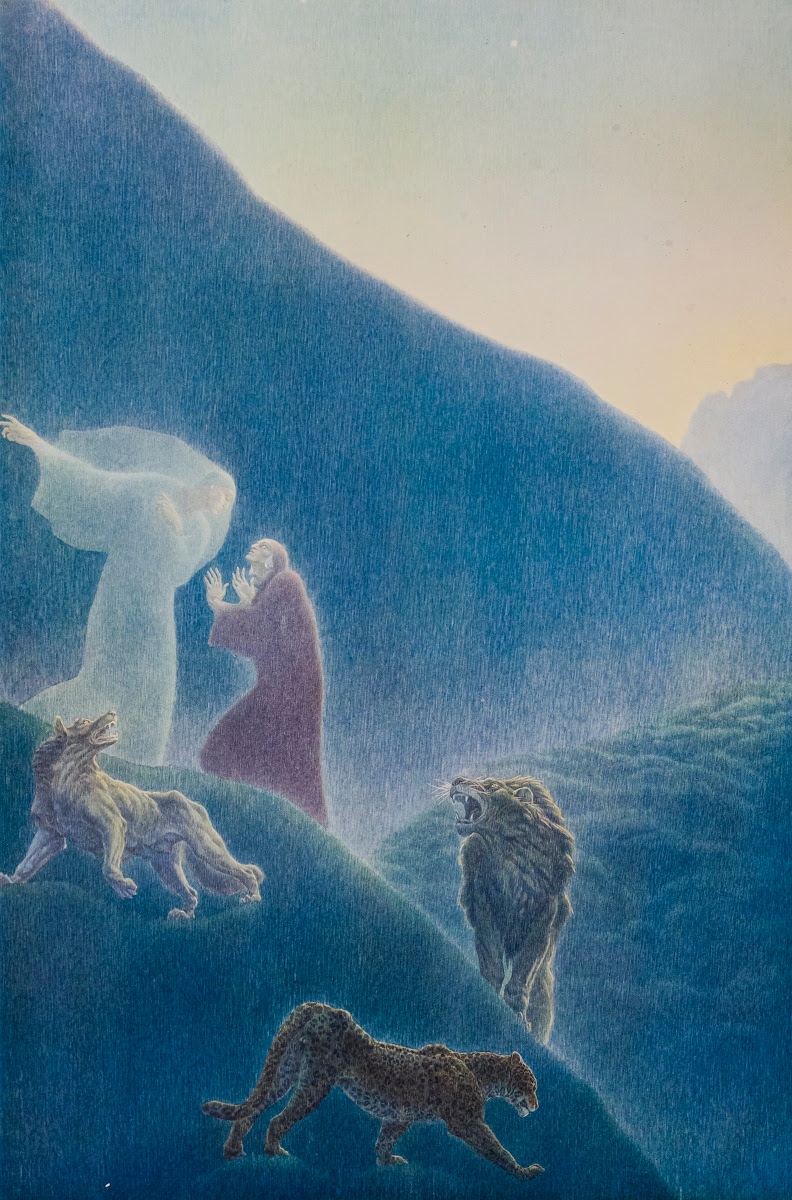“Many artists have interpreted Dante’s afterlife by letting themselves be inspired by the culture and fears of their time. Amos Nattini, between 1915 and 1939, undertakes this great project with passion and dedication, giving us an absolutely human and realistic version of it. His lithographs were published together with the Divine Comedy text in three volumes. The edition of the Cariparma Foundation is dated 1939.” — “Amos Nattini and The Divine Comedy,” Google Arts and Culture, 1900s (Retrieved March 28, 2024).
Liam Ó Broin’s Commedia Lithographs (2021)
Irish printmaker Liam Ó Broin completed a series of 100 lithographs based on Dante’s Commedia in honor of the 700th anniversary of the poet’s death in 2021. The lithographs are currently available to view in an online exhibit sponsored by the Centre for Dante Studies in Ireland (CDSI).
“Dante’s search on his journey was to go to the depths of the human imagination. In that journey he reveals himself as one who has a deep understanding of the nature, and importantly, the necessity of the human scheme of community. He also reveals, however flawed the mechanism from a political aspect was at the time, a very clear understanding of the way a city state, and by extension a nation, needs to be structured as an entity for good government – its core must be social justice. Here we have Dante the poet, Christian, philosopher and politician – fused into one.” –From the Artist’s Statement.
Read more about Liam Ó Broin’s career at the artist’s personal website.
View our previous post on Ó Broin’s 2012 Inferno exhibition at Graphic Studio (Dublin) here.
We extend our great thanks to the artist for permission to reprint the image above.
Dante Alighieri: A Suite Of Thirty-Four Lithographs
“The enduring power of Dante’s imagination in his masterpiece The Divine Comedy has inspired artists from the Middle Ages to the present. On reading this literary epic, the artist Liam Ó Broin began three years ago the daunting challenge to create 34 coloured lithographs in response to each canto of Inferno. Although faithful to Dante’s text, Ó Broin through his powerful imagery brings his personal perspective to bear on the central themes and contemporises Dante’s voyeuristic passage through the realms of Hell by portraying the Inferno of our time. As Ó Broin states ‘the one which can be created by ourselves and for others, in the here and now.’ These lithographs not only deepen our appreciation of the richness of the epic’s poetic language, but also seek to examine the multi-layered meanings of the text – universal themes of life after death, divine justice and punishment, man’s immoral actions and crimes to mankind.” [. . .] —Liam Ó Broin
The Inferno lithographs were exhibited at Graphic Studio (Dublin) in 2012.
Selected prints from Liam Ó Broin’s Inferno series, including a limited edition box set (now sold out), were available for purchase here.
“Dante and Virgil Attend an Exhibition,” Caricatures by Antonio Manganaro at Princeton University
 “Since Dante’s Divine Comedy (Divina Commedia) first appeared in 1320, visual artists have been rethinking Dante’s trip into hell with Virgil as his guide. Eugène Delacroix chose the subject for his first major painting, The Barque of Dante, also known as Dante and Virgil in Hell, which introduced the artist at the Salon of 1822. A few years later, William Blake drew visions of the Divine Comedy in London while G.G. Macchiavelli did the same in Bologna. William-Adolphe Bouguereau painted Dante and Virgil in Hell in 1850; Edgar Degas finished Dante and Virgil at the Entrance to Hell in 1858; and Gustave Doré financed his own Inferno in 1861, finishing the trilogy in 1868.
“Since Dante’s Divine Comedy (Divina Commedia) first appeared in 1320, visual artists have been rethinking Dante’s trip into hell with Virgil as his guide. Eugène Delacroix chose the subject for his first major painting, The Barque of Dante, also known as Dante and Virgil in Hell, which introduced the artist at the Salon of 1822. A few years later, William Blake drew visions of the Divine Comedy in London while G.G. Macchiavelli did the same in Bologna. William-Adolphe Bouguereau painted Dante and Virgil in Hell in 1850; Edgar Degas finished Dante and Virgil at the Entrance to Hell in 1858; and Gustave Doré financed his own Inferno in 1861, finishing the trilogy in 1868.
“In the wake of Doré’s popularity, the Italian caricaturist Antonio Manganaro (1842-1921) translated Dante’s epic to his own era, imagining what would happen if Dante and Virgil attended the opening of The International Maritime Exhibition held in Naples in 1871. Manganaro’s rare lithographic volume, recently acquired by the Graphic Arts Collection, includes plenty of ghosts, fish, and wine.” — “Dante and Virgil Attend an Exhibition,” Website of the Graphic Arts Collection, Rare Books and Special Collections, Firestone Library, Princeton University (May 20, 2017)
Watercolor Lithograph by “Mata”

Bettino Ricasoli as Count Ugolino attacks Urbano Rattazzi, who ousted him in 1892 from his leading role in the government. This piece was on exhibit at the “150 Years of La Nazione” in Florence, Italy at the Palazzo Medici Riccardi, March 7 – April 30, 2009.
Pdf close-ups of the re-written terzine:
1Download file
2Download file
3Download file
4Download file
Contributed by Kavi Montanaro


